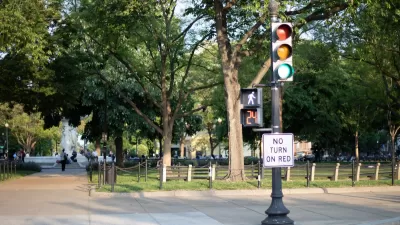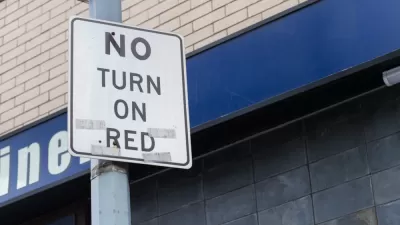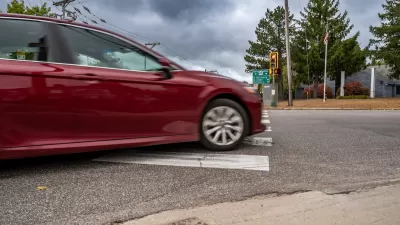Every new traffic light in the city will be required to install ‘No Turn on Red’ signs, a tactic shown to reduce collisions.

All newly installed or repaired traffic signals in Seattle will bar drivers from turning right on red. As Ryan Packer points out in The Urbanist, “The change doesn’t mean that right-on-red will be restricted every single intersection in Seattle anytime soon, but rather that every time a project within the department deals with replacing or modifying a traffic signal, SDOT will have to find a reason justifying not to add ‘no turn on red’ signage.” Allowing cars to turn right on red will now require a “significant operational reason.”
In Washington, D.C., banning right turns on red resulted in a 97 percent reduction in driver-to-driver conflicts and a 92 percent reduction in vehicle-pedestrian conflicts. According to a study published in the Institute of Traffic Engineers (ITE) journal, “These improvements came at overall minor impacts to traffic operations. These findings have helped the District identify a low-cost safety tool that will help in its pursuit of Vision Zero.”
Packer adds that “The new policy will not apply when the city does routine maintenance, or when it modifies signals to add Accessible Pedestrian Signals (APS), which provide low-vision people auditory clues that it’s safe to cross the street. The rule will also not apply when signal timing is the only thing about a signal that is modified.”
SDOT expects roughly 150 intersections will have restricted turns on red by the end of this year, “still just a fraction of the over 1,000 signalized intersections that SDOT maintains citywide.”
FULL STORY: No Right Turn on Red Is Now the Default in Seattle

Manufactured Crisis: Losing the Nation’s Largest Source of Unsubsidized Affordable Housing
Manufactured housing communities have long been an affordable housing option for millions of people living in the U.S., but that affordability is disappearing rapidly. How did we get here?

Americans May Be Stuck — But Why?
Americans are moving a lot less than they once did, and that is a problem. While Yoni Applebaum, in his highly-publicized article Stuck, gets the reasons badly wrong, it's still important to ask: why are we moving so much less than before?

Using Old Oil and Gas Wells for Green Energy Storage
Penn State researchers have found that repurposing abandoned oil and gas wells for geothermal-assisted compressed-air energy storage can boost efficiency, reduce environmental risks, and support clean energy and job transitions.

Greening Oakland’s School Grounds
With help from community partners like the Trust for Public Land, Oakland Unified School District is turning barren, asphalt-covered schoolyards into vibrant, green spaces that support outdoor learning, play, and student well-being.

California Governor Suspends CEQA Reviews for Utilities in Fire Areas
Utility restoration efforts in areas affected by the January wildfires in Los Angeles will be exempt from environmental regulations to speed up the rebuilding of essential infrastructure.

Native American Communities Prepare to Lead on Environmental Stewardship
In the face of federal threats to public lands and conservation efforts, indigenous groups continue to model nature-centered conservation efforts.
Urban Design for Planners 1: Software Tools
This six-course series explores essential urban design concepts using open source software and equips planners with the tools they need to participate fully in the urban design process.
Planning for Universal Design
Learn the tools for implementing Universal Design in planning regulations.
Heyer Gruel & Associates PA
City of Moreno Valley
Institute for Housing and Urban Development Studies (IHS)
City of Grandview
Harvard GSD Executive Education
Salt Lake City
NYU Wagner Graduate School of Public Service
City of Cambridge, Maryland





























